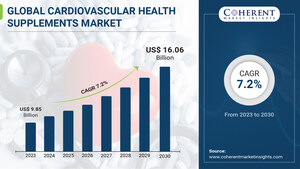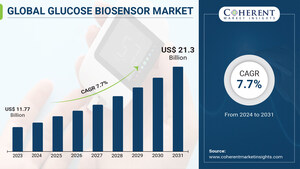SEATTLE, March 2, 2020 /PRNewswire/ -- According to Coherent Market Insights, the global infertility devices market was valued at US$ 7,104.1 million in 2018, and is expected to exhibit a CAGR of 8.4% over the forecast period (2019-2027).
Key Trends and Analysis of the Infertility Devices Market:
Key trends in market include rise in infertility with age, decreasing fertility rate, increasing adoption and awareness of assisted reproductive technology (ART) procedures, and adoption of inorganic strategies such as acquisitions, and collaborations by the market players.
Increasing preference for adoption of Assisted Reproductive Technology (ART) procedures, to address infertility problems, is expected to drive growth of infertility devices market during the forecast period. For instance, according to the European Society of Human Reproduction and Embryology (ESHRE) factsheet, February 2018, around 800,000 treatment cycles of ART were performed in Europe in 2014.
Increasing number of same sex parents driven by social acceptance is increasing the utility of other fertility services. According to the LGBTQ Family Fact Sheet, August 2017, around 2 million to 3.7 million children have same sex parents, and around 200,000 of them were being raised by a same-sex couple in 2015.
Request a Sample PDF copy of this Report @ https://www.coherentmarketinsights.com/insight/request-sample/2579
Several market players are focused on launch of new fertility clinics in the emerging economies, for offering infertility treatment in the potential market. For instance, in January 2018, Nova IVI Fertility, a chain of fertility clinics, launched new fertility center in Uttar Pradesh, India for offering infertility treatment including counseling, ultrasound monitoring, fertility evaluation of male and females, IVF, ICSI, and other procedures.
Moreover, favorable reimbursement scenario for infertility treatment is expected to decrease the healthcare burden and thereby, propel the market growth over the forecast period. For instance, according to the European Policy Audit on Fertility (EPAF) rules, reimbursement for fertility treatments is 100% for up to four IVF cycles and six IUI for women aged 22-39 years in Czech Republic.
Key Market Takeaways:
- The infertility devices market is expected to exhibit a CAGR of 8.4% during the forecast period (2019 -2027), attributed to rise in infertility with age, decreasing fertility rate, increasing adoption and awareness of Assisted Reproductive Technology (ART) procedures, increasing number of surgeries, and adoption of growth inorganic strategies such as acquisitions, and collaborations by the market players. For instance, according to the National Vital Statistics Reports, January 2018, the total fertility rate (TFR) in 2016 was around 1,820.5 births per 1,000 women, which decreased by 1% from 2015 which was around 1,843.5 births per 1,000 women in the U.S.
- Key players are focused on adopting product launch strategy for enhancing their offering in the potential untapped market, which in turn is expected to propel the market growth over the forecast period. For instance, in February 2019, Merck KGaA, a leading science and technology company, launched its technologically advanced fertility device in India. The business launched two devices, namely Geri and Gavi, as well as Gems, a complete culture medium suite.
Key players operating in the global infertility devices market include –
Carl Zeiss Meditec AG, Thermo Fisher Scientific Inc., Vitrolife AB, The Baker Company, Inc., The Cooper Companies, Inc., Fujifilm Irvine Scientific, IVFTECH APS, Kitazato Corporation, MedGyn Products, Inc., Rocket Medical plc, SOMATEX Medical Technologies GmbH, Cook Group Incorporated, Esco Micro Pte Ltd, Hamilton Thorne, Ltd, and Art Biotech Pvt. LTD
Buy this Report now (Single User License) @ https://www.coherentmarketinsights.com/insight/buy-now/2579
Detailed Segmentation:
- Global Infertility Devices Market, By Product Type:
- Equipment
- Imaging Systems
- Sperm Analyzer Systems
- Ovum Aspiration Pumps
- Micromanipulators Systems
- Incubators
- Gas Analyzers
- Laser Systems
- Cryosystems
- Accessories
- Global Infertility Devices Market, By Procedure:
- Assisted Reproductive Technology
- Artificial Insemination
- Fertility Surgery
- Others
- Global Infertility Devices Market, By Gender:
- Male
- Female
- Global Infertility Devices Market, By End User:
- Fertility Centers
- Hospitals & Surgical Clinics
- Cryobanks
- Others
- Global Infertility Devices Market, By Region:
- North America
- U.S.
- Canada
- Latin America
- Brazil
- Mexico
- Argentina
- Rest of Latin America
- Europe
- Germany
- U.K.
- France
- Italy
- Spain
- Russia
- Rest of Europe
- Asia Pacific
- China
- India
- Japan
- Australia
- South Korea
- ASEAN
- Rest of Asia Pacific
- Middle East
- GCC
- Israel
- Rest of Middle East
- Africa
- South Africa
- Central Africa
- North Africa
- Company Profiles
Didn't find what you were looking for? Here are some similar topics:
INFERTILITY DRUGS MARKET
Increasing prevalence of infertility in couples is highly contributing to infertility drugs market size. For instance, According to Centres for Disease Control and Prevention (CDC) report of 2018, about 6% of women aged 15 to 44 years in the U.S. were unable to get pregnant after one year of trying (infertility). The restraining factors for the infertility drug market growth is the potential risks of infertility drugs. Risks of infertility includes pregnancy with multiples, ovarian hyper-stimulation syndrome, long-term risks of ovarian tumours etc.
Read more details @ https://www.coherentmarketinsights.com/market-insight/infertility-drugs-market-2665
FERTILITY AND PREGNANCY RAPID TEST KITS MARKET
The device detects tiny amount of HCG, a female pregnancy hormone that increases during early stages of pregnancy in female body. The urine pregnancy test kit provides qualitative results i.e. positive or negative. It contains the test strip, which is directly exposed to the potential women's urine. The blood test kit is the most sensitive pregnancy test. The test allows the clinician to detect exact levels of HCG in women's blood, which is based on HCG molecules bound on the test strip. Factors such as availability of too many options in the market leading to confusion in buyers mind regarding quality aspects and device-related issues can hinder growth of global fertility and pregnancy testing device market.
Read more details @ https://www.coherentmarketinsights.com/market-insight/fertility-and-pregnancy-rapid-test-kits-market-3456
Contact Us:
Mr. Shah
Coherent Market Insights
1001 4th Ave.
#3200
Seattle, WA 98154
Tel: +1-206-701-6702
Email: [email protected]
SOURCE Coherent Market Insights

WANT YOUR COMPANY'S NEWS FEATURED ON PRNEWSWIRE.COM?
Newsrooms &
Influencers
Digital Media
Outlets
Journalists
Opted In






Share this article